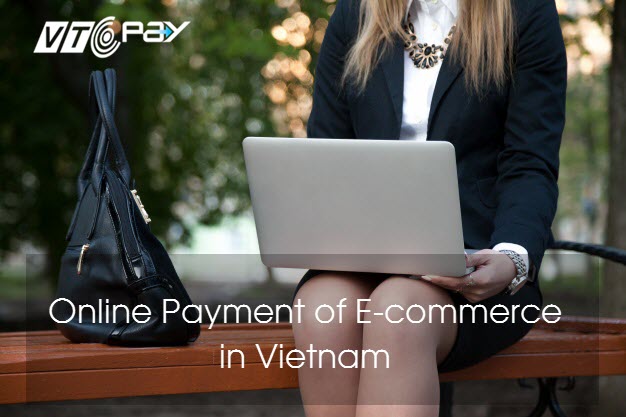The
fast growing rate of Internet users is one of the most notable aspects
of Vietnam economy with up to 40 per cent of its people using Internet.
According to statistics from the industry and trade ministry’s
E-commerce and Information Technology Agency (VECITA), Internet and
mobile play an important role in consumers’ trading with nearly 60% of
online users conducting online purchases.
Eighty
per cent of businesses will order or receive orders through e-commerce
applications on the Internet or on mobile platforms.
The
ground for e-commerce has been developed in terms of financial
infrastructure which is expected to complete by 2020, keeping up with
the development of various e-commerce models and activities in society.

Over the last five years, the strong growth of e-commerce has stimulated the e- payment
services sector. In 2010, there were 84,500 e-wallet accounts opened
with 17 banks providing services and 119 merchants accepting online
payment.
Since then, the online payment
network has been developing with POS network growing faster than ATM
due to high cost of investment and operation of ATM machines. The
payment market in Vietnam is still in early stage and very fragmented
with only 11 companies being granted the trial license, but the number
of competitors is much larger. The e-payment market in Vietnam currently
focuses on different areas like banking transfer (OnePay, SmartLink,
VNBC), e-commerce (Soha, Nganluong, Baokim), whole seller and retail,
etc.
Though
banked sector was large and grew rapidly, cash payment was still the
main payment vehicle with cash on delivery (COD) method accounting for
64% of e-commerce transactions since the benefits of e-payment are not
clear yet. Also the complex of 3D security incorporated into credit
cards and the fact that customers can return products upon delivery have
persuaded them to stick to their traditional payment method – COD.
According
to statistics from VECITA, around 97% of businesses have transfer
option for consumers and the rate has been increasing steadily in the
past few years. Meanwhile, e-wallet and internet banking do not show any
clear trends, despite the e-commerce transactions increasing by more
than 30% annually.
The online payment platforms in Vietnam
have not kept up with the development of e-commerce, which could be
attributed to consumers’ unfamiliarity with e-payment, inherent risks
associated with online financial services providers and led to the
dominance of COD method.
As
for the online vehicles, debit transaction still accounts for a large
proportion of e-payment with banks trying to grow credit cards number to
increase payment through their system. Underdeveloped credit rating
system slows down the development of credit card and the domination of
debit account puts the security on hand of consumers, which further
limit the use of online payment tools.
Banks
have put substantial efforts to upgrade banking technology in order to
manage online transactions and have become the leader in successfully
applying non-cash payment. However noncash payments were still the
exception rather than the rule. The legal system, and the habits of
authorities, companies and the general public perpetuated the use of
cash.
The government has encouraged the use of electronic payment systems and to eliminate cash payment by building an online payment
platform for e-commerce from 2016 to 2020. The government also
encourages the development of e-commerce across borders along with
export and import activities, taking up 15 per cent of B2C e-commerce
sales by 2020 which would foster epayment to reduce transaction cost.
The
recent merger between Banknetvn and Smartlink in Dec 2014 has proved
the governmental support for e-payment market. The government has agreed
to waive tax for the post-merger consolidated firm for up to five
years, subject to both parties committed to ensuring high quality for
customer usage. The transaction is also a signal of improved e-payment
facilities to keep up with other markets through reduced controlling
cost and better customer services.
It
is expected that one hundred per cent of supermarkets, shopping malls
and distribution chains will cooperate point of sale (POS) system,
reaching the target of 250,000 POS at the end of 2015 and allowing
non-cash payment when purchasing.
However
it may question those parties as to whether the limitations of
e-payment vehicles in Vietnam actually hinder the development of
e-commerce market. In the summer 2014, $3bn poured into India’s
e-commerce sector, where more than 200 digital commerce startups flush
with private investment and venture capital funds and most of these
online vendors largely operate on cash on delivery basis. Despite the
heavy dependence on cash of India and some other countries including
Indonesia and Colombia, digital marketplaces are innovating at a
remarkable pace. But in the near future, nimble e-commerce players are
simply working with and around the persistence of cash.
The
South East Asian region comprising of Singapore, Malaysia, Thailand,
Indonesia is experiencing an up surge in e-commerce thanks to
well-established infrastructure, and resolving online payment
was amongst the first issues to be taken care of. The development of
e-payment platform in those countries has confirmed the unavoidable
market trend toward online payment for e-commerce in Vietnam, especially
when the online trading businesses are trying to expand abroad. However
how long it would take for to reach the oversea standard is still a
puzzle for Vietnamese e-commerce market.
From J&J (Trung Anh Nguyen and Phuong Do, IDG Vietnam)
Không có nhận xét nào:
Đăng nhận xét